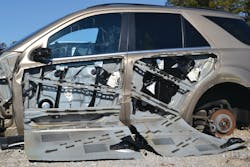SUBJECT: Opening Jammed Doors
TOPIC: Door Collision Beams
OBJECTIVE: Response personnel shall explain how to work with the collision beam of a door when required during a jammed-door evolution
TASK: Using a door of an acquired vehicle, the rescuer shall remove the outer door panel, identify the collision beam(s) and attachment points inside the door and demonstrate how door collision beam(s) can be worked with when required during a jammed-door evolution.
The University of Extrication series previously addressed important changes and challenges presented by door collision beams in the April 2000 edition of Firehouse® Magazine. At that time, automakers had just begun transitioning from mild steel beams to collision beams made of tougher, Boron-type steels. During this same time frame, the positioning of door beams inside the hollow of the door began to change. This 2014 update provides an update on door collision beam design and addresses important points for rescue personnel to understand when a collision beam needs to be dealt with during a jammed-door evolution.
First, it must be understood by all rescue personnel that the actual steel that the beam is made of may in fact be the highest tensile strength found anywhere in that entire vehicle. The 2014 Fiat 500L and the 2010-2014 Ford Edge are just two examples of this situation. The use of Boron steel for collision beams, possibly as a thick-walled pipe, began more than 15 years ago and remains a popular design for today’s vehicles. That means that at an extrication, where the collision beam may be jammed into the A- or B-pillar and needs to be dealt with, a power cutter designed to cut ultra-high-strength steels would be required if the beam needs to be cut.
In such a scenario, if rescue personnel need to cut the door collision beam, it should be noted that despite the fact that they may be made of the hardest, toughest steel found in that entire vehicle, they are attached to the ends of the door structure with a single layer of mild steel – typically spot welded into place. This is a great teaching point for extrication crews to understand. If a door collision beam needs to be moved, removed or cut for some reason, remember that the collision beam can be attacked relatively easily at either end. That is where you will find the one layer of mild steel with one or several spot welds holding the beam into place.
Another teaching point regarding door collision beams on late-model vehicles is their location, position and orientation. In the past, the beams typically ran horizontally along the center of the door. This is no longer a common design. Many late-model vehicles use multiple beams and have them positioned on angles, sometimes low within the door cavity. There is no easy way that a responder at a crash scene can anticipate where the beam is and how it is positioned; it’s inside the door somewhere. Auto engineers design their beams to transfer collision energy around the occupant area in the most efficient manner possible. Because of this, rescue personnel will be hard pressed to know exactly how a beam is positioned. This author utilizes the Crash Recovery System extrication software to quickly identify collision-beam positioning. In lieu of having this software available on-scene, peeling the outer door panel away will reveal the location of the one or two beams inside the door.
TASK: Using a door of an acquired vehicle, the rescuer shall remove the outer door panel, identify the collision beam(s) and attachment points inside the door and demonstrate how door collision beam(s) can be worked with when required during a jammed-door evolution.
Teaching points for extrication crews
- Multiple collision beams
- Multiple locations within the door
- Ultra-high-strength steels
- Single-layer attachment to the door
About the Author
Ron Moore
RON MOORE, who is a Firehouse contributing editor, recently retired as a division chief with the McKinney, TX, Fire Department and now serves with Prosper, TX, Fire Rescue. He self-published the Vehicle Rescue 1-2-3 training manual and serves as the forum moderator for the extrication section of Firehouse.com . Moore can be contacted directly at [email protected].

